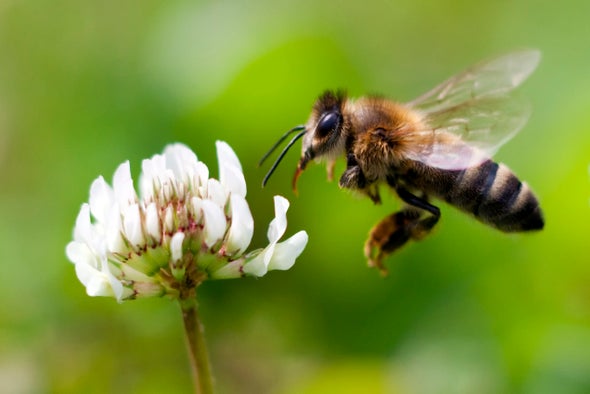(单词翻译:单击)
听力文本
This is Scientific American's 60-second Science, I'm Annie Sneed.
It takes a big brain—a human brain—to do math. Or so you might assume. But scientists have found that other animals, such chimpanzees, monkeys, and even pigeons can perform some addition and subtraction. Now new research shows that honeybees—with brains the size of sesame seeds—can perform basic math.
Researchers put honeybees through 100 trials to train them to add and subtract. They put the bees in a Y-shaped maze and presented them with a certain number of either yellow or blue shapes. Yellow indicated the bee should subtract, while blue meant they should add.
The bee then entered the "decision chamber," where it was presented with a correct answer on one side and an incorrect answer on the other side. If they picked the right answer they were rewarded with a sugary solution. If not, they got bitter tonic water. The researchers also put the bees through another test trial without a reward or punishment to make sure there weren't any scent marks influencing the bees' choices.

At first the bees picked answers at random. "You see that the ability of the bees to do it starts at about chance level, 50%, showing us the bees are just choosing randomly. But over time, competence comes up to about 80%, so they actually start to perform quite well."
Scarlett Howard, one of the study authors and a postdoctoral research fellow in neurobiology and cognition at Paul Sabatier University in France. She says the bees were even able to add and subtract correctly when presented with a number they had never seen before. The study is in the journal Science Advances.
"Things like this let us know there's a lot of complexity there and their brains might not be as simplistic as we once thought."
Thanks for listening for Scientific American — 60-Second Science. I'm Annie Sneed.
参考译文
这里是科学美国人——60秒科学系列,我是安妮·斯尼德。
做数学题需要用大脑——人类的大脑。或者你可以这样假设。但科学家发现,黑猩猩、猴子、甚至鸽子等其它动物也能做一些加法和减法。现在,新研究表明,大脑只有芝麻般大小的蜜蜂也可以进行基本的数学运算。
研究人员让蜜蜂进行了100次试验,以训练它们做加法和减法。他们将蜜蜂放入一个Y字迷宫中,给它们展示特定数量的黄色或蓝色模型。黄色表示蜜蜂应该做减法,而蓝色表示蜜蜂应该做加法。
之后,蜜蜂进入“决策室”,里面一边放有正确答案,另一边放有错误答案。如果蜜蜂选择了正确答案,它们就能得到含糖溶液作为奖励。但如果选错答案,那它们得到的就是苦味的奎宁水。研究人员还让蜜蜂进行了另一项没有奖惩机制的试验,以确保没有任何气味标记影响蜜蜂的选择。
超初,蜜蜂随机选择答案。“你可以看到蜜蜂的选择能力,开始时正确率与机会水平差不多,大约是50%,这表明蜜蜂只是随机选择。但随着时间的推移,它们的正确率上升至80%左右,可以说它们开始表现得非常好了。”
斯嘉丽·霍华德是这项研究的作者之一,也是法国保尔·萨巴蒂赫大学的神经生物学和认知学博士后研究员。她说,蜜蜂甚至能用从未见过的数字正确地做加减法。这项研究发表在《科学进展》期刊上。
“这种事情让我们知道,现实中存在很多复杂性,蜜蜂的大脑可能并不像我们曾经认为的那样简单。”
谢谢大家收听科学美国人——60秒科学。我是安妮·斯尼德。
译文为可可英语翻译,未经授权请勿转载!
重点讲解
重点讲解:
1. reward with 奖赏;奖励;酬谢;
She was rewarded for her efforts with a cash bonus.
她因自己所作的努力而得到一笔奖金。
2. make sure 一定要;设法保证;
Make sure you are strapped in very well, or else you will fall out.
一定要系好安全带,否则会摔出去。
3. at first 最初;起初;开始时;
Dart, who had at first been very tense, at last relaxed.
起初,达特非常紧张,最后终于放松了下来。
4. at randowm 随机地;偶然地;
We received several answers, and we picked one at random.
我们收到了一些答复,并从中随机挑选了一个。


